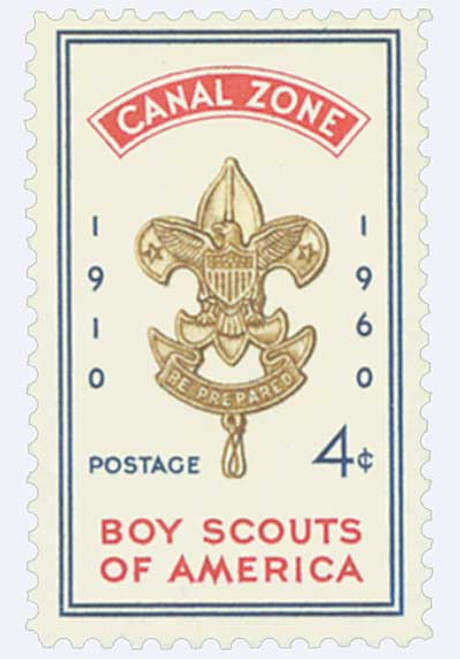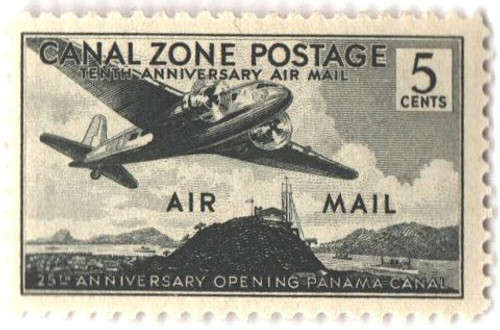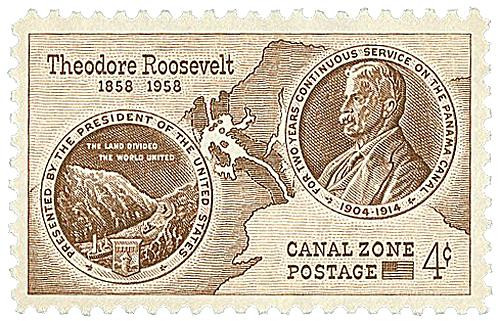
# CZ149 - 1958 4c Canal Zone - S.S. Ancon, greenish blue
CZ149 – 1958 4¢ S.S. Ancon
The S.S. Ancon was an American steamship that held the honor of being the first ship to pass through the Panama Canal in 1914.
Canal Zone Stamps Chronicle America’s Rise as a World Power
If you’ve never collected Canal Zone stamps before, now’s the time to start. These intriguing stamps are historic links to our nation’s past. With Mystic as your collecting partner, it’s easy to own stamps documenting this remarkable American engineering feat!
With military assistance from the United States, Panama declared its independence from Columbia on November 3, 1903. The Hay-Bunau-Varilla Treaty was negotiated, than ratified in Panama on December 2, 1903. The United States followed suit on February 23, 1904, clearing the way for a long-anticipated canal project across the Panama isthmus.
Almost immediately, administrators began preparations for the tremendous influx of people who would eventually assemble to work on the project. Faced with the knowledge that most of the work force would be imported to the region from America and Caribbean countries, authorities quickly established a postal service to serve their needs as well as those of the Canal Commission.
On June 24, 1904, postal service was established as part of the U.S. Department of Revenue under the supervision of the Treasurer of the Canal Zone, Paymaster E.C. Tobey. On this day, post offices were opened in Ancon, Cristóbal, Gatun, Culebra, and Balboa. Railroad station agents operated as postmasters.
A small supply of 2¢, 5¢, and 10¢ Panama stamps were overprinted “Canal Zone.” Only ordinary mail was handled by the Canal Zone postal system. Mail destined for Central and South America and the West Indies was turned over to the Panama postal service to be forwarded, while mail sent to the United States and its territories and possessions were sent to the U.S. aboard vessels departing for New York.
Overprinted Panama stamps were in use for less than a month. On July 18, 1904, they were replaced by U.S. postage stamps overprinted “Canal Zone.”
In December of 1904, Secretary of War William Taft ordered the overprinted U.S. stamps to be withdrawn, and replaced them with overprinted Panama stamps. Taft’s executive order was reversed in 1924, when overprinted U.S. stamps were placed in use again.
On October 1, 1928, the first permanent issue Canal Zone stamp was issued. The 2¢ stamp featured Lt. Col. George W. Goethal, the Canal project’s chief engineer and first Canal Zone governor.
In 1929, the first Canal Zone Airmail stamp was issued and in 1941, a series of Officials were produced. On October 25, 1978, the last Canal Zone stamp was issued.
Opening of the Panama Canal
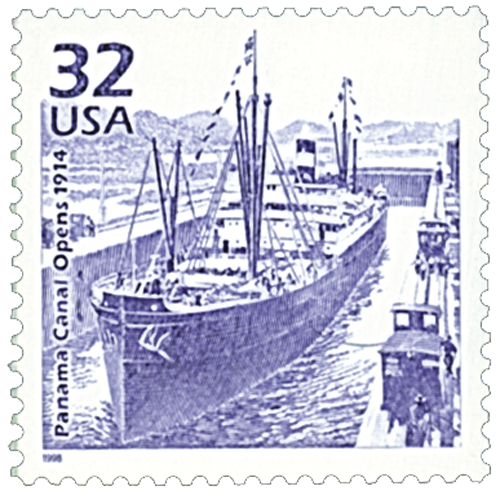
After a decade of construction, the Panama Canal opened to traffic on August 15, 1914. Dubbed one of the seven wonders of the modern world, the canal helped to significantly cut down on the travel time between the Atlantic and Pacific Oceans.
Proposals for a canal across Nicaragua or Panama began as early as 1889. United States’ public opinion of the canal was generally unfavorable until 1898, when the battleship Maine blew up at a Cuban naval base. As the Spanish-American War loomed, the battleship Oregon sailed through San Francisco’s Golden Gates to save the day. The eyes of the world were on its 16,000-mile course around Cape Horn and through the dangerous Strait of Magellan. The 67-day journey clearly showed the military significance of an isthmian canal. However, President McKinley was assassinated before he could negotiate rights to a canal.

Successor Theodore Roosevelt saw the canal as vital to America’s role as a global power. With negotiations underway in both Nicaragua and Panama, Roosevelt’s strained relationship with Columbia and the asking price of $100 million for the Panama venture could have tipped the scales in favor of a Nicaraguan canal. However, a Nicaraguan postage stamp picturing a volcano was sent to every US senator, stating it could cause problems, and that Panama had no volcanoes. This helped persuade the US Senate’s decision. Construction began in 1904.

Almost immediately, administrators began preparations for the tremendous influx of people who would eventually assemble to work on the project. Faced with the knowledge that most of the work force would be imported to the region from America and Caribbean countries, authorities quickly established a postal service to serve their needs as well as those of the Canal Commission. A postal service was established in June 1904, using Panama stamps overprinted “Canal Zone.” Later, US stamps were overprinted, and eventually brand-new Canal Zone stamps were produced.
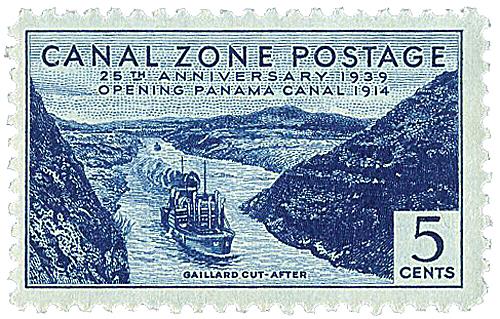
In November of 1906, President Theodore Roosevelt became the first president to travel outside the continental United States. His visit to the Panama Canal Zone reflected an evolution in his views regarding the canal’s role in the world. While he initially spoke of the canal in terms of a political, commercial, and military necessity, Roosevelt now allowed himself to be inspired by the romance of the project. Roosevelt spoke of the dramatic challenges in its structural design and of the tremendous difficulties that must be overcome to complete the project – a mighty battle involving both national honor and that of the work force.
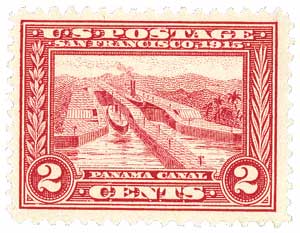
The construction was an arduous undertaking, costing the US $375 million and 5,600 lives. Over the course of the 10-year project, over 75,000 people from the US, Barbados, Martinique, Guadeloupe, and other nearby islands braved the harsh conditions to help make the canal a reality.
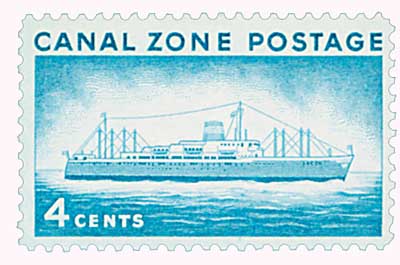
A grand celebration was to be held on August 15, 1914, to celebrate the official opening of the Panama Canal. A fleet of international warships was to assemble off Hampton Roads, Virginia. From there, they would travel through the Panama Canal to San Francisco for the Panama-Pacific International Exposition.
However, World War I intervened. The grand opening was a modest affair. There were no international dignitaries in attendance, although Colonel Goethals watched from a railcar as the cement-carrying American steamship SS Ancon traveled the canal.
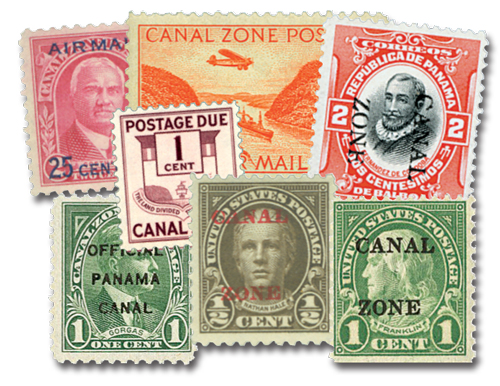
When it first opened, the canal saw annual traffic of about 1,000 ships, and that number rose to over 14,000 in the 2000s. The canal has been updated and expanded over the years and the average ship takes a little over 11 hours to get through the locks.
CZ149 – 1958 4¢ S.S. Ancon
The S.S. Ancon was an American steamship that held the honor of being the first ship to pass through the Panama Canal in 1914.
Canal Zone Stamps Chronicle America’s Rise as a World Power
If you’ve never collected Canal Zone stamps before, now’s the time to start. These intriguing stamps are historic links to our nation’s past. With Mystic as your collecting partner, it’s easy to own stamps documenting this remarkable American engineering feat!
With military assistance from the United States, Panama declared its independence from Columbia on November 3, 1903. The Hay-Bunau-Varilla Treaty was negotiated, than ratified in Panama on December 2, 1903. The United States followed suit on February 23, 1904, clearing the way for a long-anticipated canal project across the Panama isthmus.
Almost immediately, administrators began preparations for the tremendous influx of people who would eventually assemble to work on the project. Faced with the knowledge that most of the work force would be imported to the region from America and Caribbean countries, authorities quickly established a postal service to serve their needs as well as those of the Canal Commission.
On June 24, 1904, postal service was established as part of the U.S. Department of Revenue under the supervision of the Treasurer of the Canal Zone, Paymaster E.C. Tobey. On this day, post offices were opened in Ancon, Cristóbal, Gatun, Culebra, and Balboa. Railroad station agents operated as postmasters.
A small supply of 2¢, 5¢, and 10¢ Panama stamps were overprinted “Canal Zone.” Only ordinary mail was handled by the Canal Zone postal system. Mail destined for Central and South America and the West Indies was turned over to the Panama postal service to be forwarded, while mail sent to the United States and its territories and possessions were sent to the U.S. aboard vessels departing for New York.
Overprinted Panama stamps were in use for less than a month. On July 18, 1904, they were replaced by U.S. postage stamps overprinted “Canal Zone.”
In December of 1904, Secretary of War William Taft ordered the overprinted U.S. stamps to be withdrawn, and replaced them with overprinted Panama stamps. Taft’s executive order was reversed in 1924, when overprinted U.S. stamps were placed in use again.
On October 1, 1928, the first permanent issue Canal Zone stamp was issued. The 2¢ stamp featured Lt. Col. George W. Goethal, the Canal project’s chief engineer and first Canal Zone governor.
In 1929, the first Canal Zone Airmail stamp was issued and in 1941, a series of Officials were produced. On October 25, 1978, the last Canal Zone stamp was issued.
Opening of the Panama Canal

After a decade of construction, the Panama Canal opened to traffic on August 15, 1914. Dubbed one of the seven wonders of the modern world, the canal helped to significantly cut down on the travel time between the Atlantic and Pacific Oceans.
Proposals for a canal across Nicaragua or Panama began as early as 1889. United States’ public opinion of the canal was generally unfavorable until 1898, when the battleship Maine blew up at a Cuban naval base. As the Spanish-American War loomed, the battleship Oregon sailed through San Francisco’s Golden Gates to save the day. The eyes of the world were on its 16,000-mile course around Cape Horn and through the dangerous Strait of Magellan. The 67-day journey clearly showed the military significance of an isthmian canal. However, President McKinley was assassinated before he could negotiate rights to a canal.

Successor Theodore Roosevelt saw the canal as vital to America’s role as a global power. With negotiations underway in both Nicaragua and Panama, Roosevelt’s strained relationship with Columbia and the asking price of $100 million for the Panama venture could have tipped the scales in favor of a Nicaraguan canal. However, a Nicaraguan postage stamp picturing a volcano was sent to every US senator, stating it could cause problems, and that Panama had no volcanoes. This helped persuade the US Senate’s decision. Construction began in 1904.

Almost immediately, administrators began preparations for the tremendous influx of people who would eventually assemble to work on the project. Faced with the knowledge that most of the work force would be imported to the region from America and Caribbean countries, authorities quickly established a postal service to serve their needs as well as those of the Canal Commission. A postal service was established in June 1904, using Panama stamps overprinted “Canal Zone.” Later, US stamps were overprinted, and eventually brand-new Canal Zone stamps were produced.

In November of 1906, President Theodore Roosevelt became the first president to travel outside the continental United States. His visit to the Panama Canal Zone reflected an evolution in his views regarding the canal’s role in the world. While he initially spoke of the canal in terms of a political, commercial, and military necessity, Roosevelt now allowed himself to be inspired by the romance of the project. Roosevelt spoke of the dramatic challenges in its structural design and of the tremendous difficulties that must be overcome to complete the project – a mighty battle involving both national honor and that of the work force.

The construction was an arduous undertaking, costing the US $375 million and 5,600 lives. Over the course of the 10-year project, over 75,000 people from the US, Barbados, Martinique, Guadeloupe, and other nearby islands braved the harsh conditions to help make the canal a reality.

A grand celebration was to be held on August 15, 1914, to celebrate the official opening of the Panama Canal. A fleet of international warships was to assemble off Hampton Roads, Virginia. From there, they would travel through the Panama Canal to San Francisco for the Panama-Pacific International Exposition.
However, World War I intervened. The grand opening was a modest affair. There were no international dignitaries in attendance, although Colonel Goethals watched from a railcar as the cement-carrying American steamship SS Ancon traveled the canal.

When it first opened, the canal saw annual traffic of about 1,000 ships, and that number rose to over 14,000 in the 2000s. The canal has been updated and expanded over the years and the average ship takes a little over 11 hours to get through the locks.







